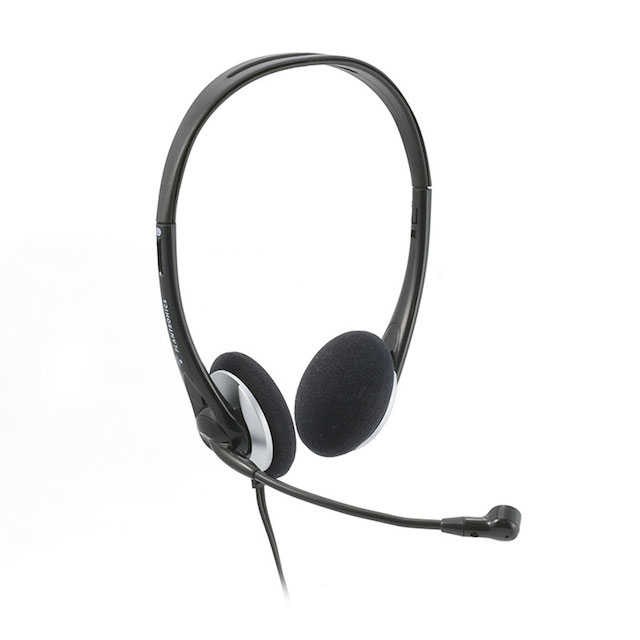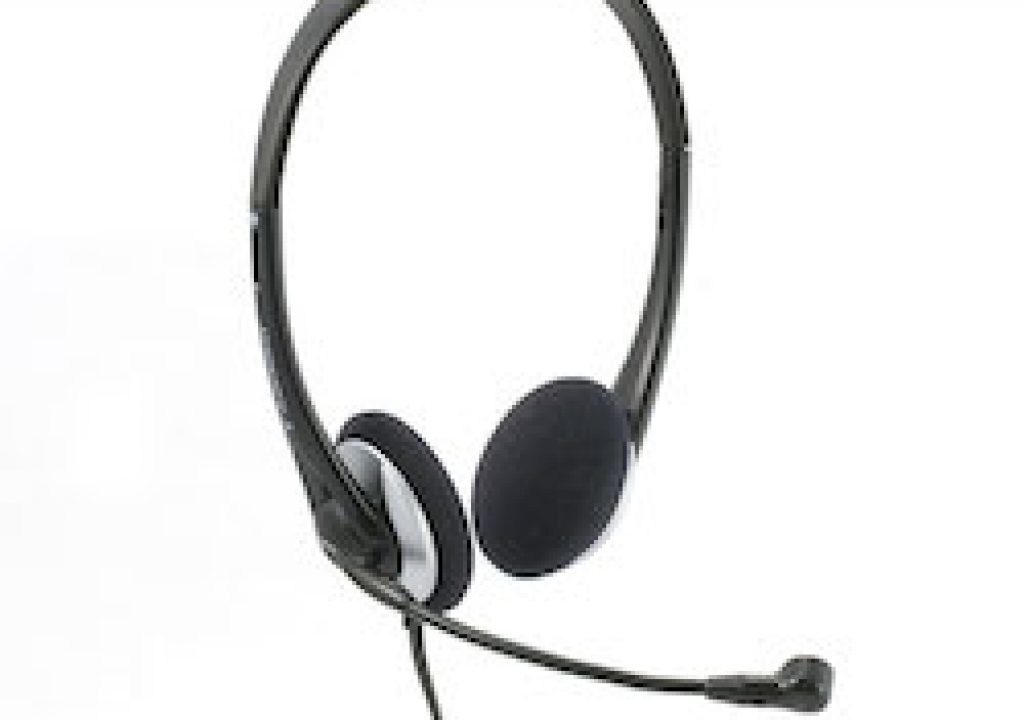
Plantronics is a renowned headset manufacturer for office communication, general listening, mobile telephony, and gaming, but not for broadcast or multimedia production. However, due to an unusual set of circumstances, I discovered that their completely analog Plantronics .Audio 326 headset (when combined with a portable preamp/A>D converter) transforms itself into an ultra-affordable broadcast headset for production and live streaming. Here’s my review with test recording.
In this article, I am only covering the Plantronics .Audio 326 headset, together with 48 kHz test recordings and potential broadcast & production applications. This article will not cover the detailed integration with a portable preamp/A>D converter with its two analog microphone inputs. I will cover that in a separate review.
Here is a 48 kHz, 24 bit recording made from the Plantronics .Audio 326 via the mentioned portable preamp A>D (analog-to-digital) converter. By clicking on the player, you’ll be streaming the compressed MP3 which as been encoded by SoundCloud. If you wish, you may download the original uncompressed 48 kHz WAVE file.
To download the original uncompressed 48 kHz WAVE files, and/or if you have difficulty hearing the streaming files here on this page, click on the SoundCloud logo in the corner of the player. You’ll be brought to the files on the SoundCloud site, where you can stream or download.
Production applications for the Plantronics .Audio 326 headset
Initially, I was searching for a headset (with built-in microphone) that would match the mentioned portable preamp/A>D converter for those documentary-style productions where a single person must simultaneously operate the camera, monitor the audio recording, ask questions of an interviewee, and be recorded on an independent audio track for full control in post production. So that was the first application I found for the Plantronics .Audio 326 headset. I was specifically searching for a headset whose native terminations would match the inputs of the preamp/A>D converter, to avoid the complication, bulk and unreliability of physical adapters. Fortunately, I found exactly what I was seeking with the Plantronics .Audio 326 headset.
The second application was when David Basulto (creator of the iOgrapher) asked me for a recommendation for broadcast headsets for live sports commentary, together with a way of connecting two such headsets simultaneously to an iPad. David used two Plantronics .Audio 326 headsets with the referenced portable preamp/A>D converter and the Livestream app to webstream live, with excellent results.
About the Plantronics .Audio 326
The Plantronics .Audio 326 is completely analog, which makes it work so well with this application. Since it is completely analog, when used with the mentioned portable preamp/A>D converter, up to two different microphones may be connected, and each of the microphones can be recorded on separate tracks (dual mono disguised as “stereo”) or summed to mono, if desired for a live application. As shipped by the manufacturer, the Plantronics .Audio 326 headset has a 1.8 meter (5 feet and 6.92 inches) cable that terminates in two independent TRS 3.5 mm plugs: one for the unbalanced microphone, and the other for the inboard stereo headphones. [Unbalanced mono microphones typically terminate in TS, TRS (for compatibility with inputs that expect stereo), or TRRS (to connect to mobile telephones).] Each TRS 3.5 mm plug on the Plantronics .Audio 326 headset is identified for its role with a symbol of a microphone on one, and of headphones on the other. The fact that they are separate TRS plugs (not a single TRRS) is perfect for use with the mentioned portable preamp/A>D converter, since it accepts the microphone plug directly (without requiring any other adapter or modification), and the headphone is plugged directly into the recorder’s output, which also accepts it directly (without requiring any other adapter or modification). Although the microphone connection is unbalanced, it doesn’t matter since the cable is so short.
The Plantronics .Audio 326 headset’s microphone boom is both rotatable and bendable. The cable has a built-in user volume control potentiometer (for listening) and a microphone mute switch. Regarding the microphone itself, Plantronics says very little: only that it is noise canceling. I must conclude that it is electret condenser since it only works when it receives bias voltage (aka plugin power), which —as stated in prior articles— is similar, but not the same as phantom power. Fortunately, the mentioned portable preamp/A>D converter offers the necessary power with the flick of a switch.
Conclusions
Physically, the Plantronics .Audio 326 headset is very light and comfortable, but seems a bit fragile, and when in my knapsack the plastic earpieces snapped off more than once, but easily snapped on again. If you are planning to use them as part of a portable kit, I would recommend using a special protected compartment or acquiring an appropriate hard case. Although as stated earlier, each plug is identified with a symbol of a microphone and headphones, I would recommend marking one of them to suit your taste to make it more obvious at first glance which is which. The Plantronics .Audio 326 includes a two year limited warranty. With a street price of only US$12.46 (yes, this is not a mistype: it is really twelve US dollars and 46 cents at publication time of this article)… and considering that traditional broadcast headsets typically start at over US$150 and often cost much more, the Plantronics .Audio 326 headset really represents a phenomenal value for the price and is likely to open a brand new market for the manufacturer, especially given the explosions of iOS mediography and the frequent requirement to connect more than one microphone, often to be recorded on separate audio tracks. Given its price, value, and potential fragility, you might consider having some spares on hand.
Standby for the review on the portable preamp/A>D converter, with more integration with this and other appropriate microphones.
Upcoming articles, reviews, and books
Stand by for upcoming articles, reviews, and books. Sign up to my free mailing list by clicking here.
Si deseas suscribirte a mi lista en castellano, visita aquí. Si prefieres, puedes suscribirte a ambas listas (castellano e inglés).
Books, consulting, articles, seminars & audio programs
Contact Allan Tépper for consulting, or find a full listing of his books, articles and upcoming seminars and webinars at AllanTepper.com. Listen to his CapicúaFM and TecnoTur programs. Search for CapicúaFM TecnoTur in iTunes or Stitcher Radio.
My latest book (paperback + ebook)
My most recent book is available in two languages, and in paperback as well as an ebook. The ebook format is Kindle, but even if you don’t have a Kindle device, you can read Kindle books on many other devices using a free Kindle app. That includes iPad, Android tablets, Mac computers, and Windows computers. Although generally speaking, Kindle books are readable on smartphones like Androids and iPhones, I don’t recommend it for this particular book since it contains both color photos and color comparison charts. The ebook is also DRM-free.
In English:
In English, it is currently available in the following Amazon stores, depending upon your region:
- Amazon.com, for the US and other countries in the Americas that don’t currently have their own Amazon store, or anywhere if you simply prefer it
- Amazon.br for Brazil
- Amazon.ca for Canada
- Amazon.de for Germany
- Amazon.es for Spain pero a lo mejor lo preferirás en castellano, a continuación)
- Amazon.fr for France
- Amazon.in for India
- Amazon.it for Italy
- Amazon.co.jp for Japan
- Amazon.com.mx for México
- Amazon.co.uk for the United Kingdom
Or in your favorite bookstore by requesting ISBN–10: 1456310232 or ISBN–13: 978–1456310233.
En castellano:
En castellano, está disponible actualmente en las siguientes tiendas Amazon, según tu región:
- Amazon.com para EE.UU. y todas las Américas donde no existe ninguna tienda particular… o en cualquier parte si simplemente lo prefieres
- Amazon.com.br para Brasil
- Amazon.co.jp para Japón
- Amazon.de para Alemania
- Amazon.es para España
- Amazon.fr (Francia)
- Amazon.in para India
- Amazon.it para Italia
- Amazon.com.mx para México
- Amazon.co.uk para el Reino Unido
o en tu librería preferida al solicitar el ISBN–10: 1492783390 ó el ISBN–13: 978–1492783398.
FTC disclosure
No manufacturer is specifically paying Allan Tépper or TecnoTur LLC to write this article or the mentioned books. Some of the other manufacturers listed above have contracted Tépper and/or TecnoTur LLC to carry out consulting and/or translations/localizations/transcreations. Many of the manufacturers listed above have sent Allan Tépper review units. So far, none of the manufacturers listed above is/are sponsors of the TecnoTur programs, although they are welcome to do so, and some are, may be (or may have been) sponsors of ProVideo Coalition magazine. Some links to third parties listed in this article and/or on this web page may indirectly benefit TecnoTur LLC via affiliate programs.
Copyright and use of this article
The articles contained in the TecnoTur channel in ProVideo Coalition magazine are copyright Allan Tépper/TecnoTur LLC, except where otherwise attributed. Unauthorized use is prohibited without prior approval, except for short quotes which link back to this page, which are encouraged!

